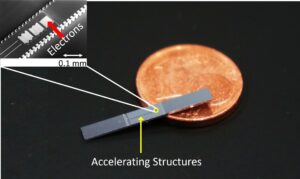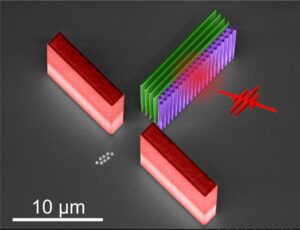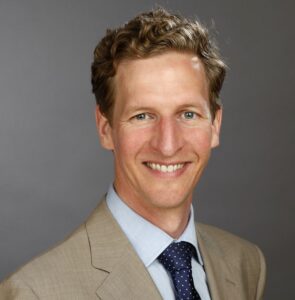ERC Advanced Grant for physicist Prof. Dr. Peter Hommelhoff

2.5 million euros for revolutionary particle accelerator
Not only another successful bid for competitive research funding, but a remarkable demonstration of Erlangen as a key location for scientific research: Prof. Dr. Peter Hommelhoff, Chair of Laser Physics at Friedrich-Alexander-Universität Erlangen-Nürnberg (FAU), has received an ERC Advanced Grant. The grant provides funding of 2.5 million euros over five years. The funded project aims to develop minute particle accelerators using photon chips. Research in this field will enable innovation in imaging methods and materials analysis, allow new approaches in medical radiation therapies and help to answer fundamental questions in quantum physics. It is not the first time that Professor Hommelhoff has received one of the prestigious grants from the European Research Council (ERC), he was also awarded an ERC Consolidator Grant in 2014.
Miniaturising giants
Many people associate the giant ring at CERN in Switzerland with particle accelerators. In the underground tubes at CERN, researchers accelerate atomic nuclei at high speeds, causing them to collide with each other. The aim is to learn more about the fundamentals of atomic matter. In large installations such as the European X-ray laser at DESY in Hamburg, particle accelerators are also used in large electron microscopes for investigating new materials and pharmaceutical active ingredients. Particle accelerators are also part of our everyday lives. ‘Modern medical imaging methods cannot do without them,’ explains FAU physicist Prof. Dr. Peter Hommelhoff. ‘They are also used in radiation oncology clinics to treat tumours using linear electron accelerators.’ Particle accelerators in clinical practice are already much smaller than in large research facilities, as less particle energy is required for these applications.

But Peter Hommelhoff and his team want to go even further. They are working on a particle accelerator that will be no larger than a microchip. ‘We aim to reduce the size of common particle accelerators by a factor of 100 – clinical accelerators could become about one centimetre smaller,’ explains Prof. Hommelhoff. The photonic accelerator itself consists of an electron channel which is etched into a glass plate. The walls of the tiny channel are corrugated. When light is fired into the channel, it is changed by the complex structure in such a way that the electron rides the light waves like a surfer, propelling it onwards. At the end of the acceleration, the electron should be as energy-rich as in one of the larger accelerators commercially available today.
Application and basic research

Practical application is an important aspect in Hommelhoff’s project. ‘Thanks to its small size, it is now conceivable to introduce such an accelerator into a catheter which could be used for treating diseased tissue quite specifically,’ he says. Electron pulses of one attosecond in length – one billionth of a billionth of a second – should also be possible with the accelerator. This could allow rapid processes to be recorded in super slow motion, such as the course of fractures in fracture tests of novel ceramics or how electrons behave when a molecule is split. Hommelhoff’s accelerator will also be used in basic research. ‘We want to excite and de-excite atoms in a controlled manner without emitting light,’ explains Prof. Hommelhoff. ‘If this were to succeed, it would be the highest form of quantum control over the atom.’
For Peter Hommelhoff, the ERC Advanced Grant is an important award. ‘This would not have been possible without the excellent work of my team and the infrastructure that FAU offers,’ says the physicist. ‘ERC Grants show where world-class research is being conducted.’ Although Professor Hommelhoff’s name is on the award, the research would not have been possible without the entire team.
About Professor Hommelhoff

Prof. Dr. Peter Hommelhoff has held the Chair of Laser Physics at FAU since 2012. In 2014, he was awarded the ERC Consolidator Grant for his research investigating the interaction of light and solids such as sharp metal tips or graphenes. From 2003 to 2007, Hommelhoff was a postdoctoral researcher in Stanford, and from 2008 he led a Max Planck Research Group at the Max Planck Institute for Quantum Optics (MPQ) in Garching, before joining FAU. From 2012 to 2018 he was associate member of the Max Planck Institute for the Physics of Light (MPL), Erlangen, and has been a fellow of the MPL since 2018. He has also been a member of the Board of Directors of the German Physical Society since 2018. Hommelhoff is not only regarded as an outstanding scientist, he also has an outstanding reputation in teaching. In 2017, he was awarded the ‘Prize for Excellence in Teaching’ for the lectures Experimental Physics 1 and 2 by the Department of Physics at FAU.
Further Information:
Prof. Dr. Peter Hommelhoff
Tel.: 09131/85-27090
peter.hommelhoff@physik.uni-erlangen.de